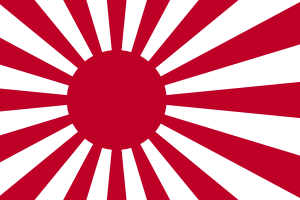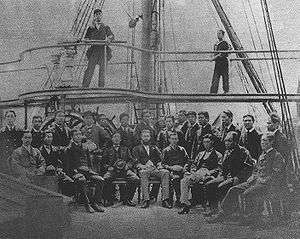For other ships of the same name, see
Ryūjō.
 |
| History |

|
| Name: |
Ryujo |
| Builder: |
Alexander Hall and Company, Aberdeen |
| Laid down: |
1868 |
| Launched: |
- 27 March 1869
- or January 1864
|
| Completed: |
- 11 August 1869
- or 24 July 1869
|
| Decommissioned: |
2 December 1893 |
| Fate: |
|
| General characteristics |
| Displacement: |
2,530 long tons (2,571 t) standard |
| Length: |
- 211 ft (64 m)
- or 64.5 m (211 ft 7 in)
- or 65.9 m (216 ft 2 in)
|
| Beam: |
- 12.5 m (41 ft 0 in)
- or 12.8 m (42 ft 0 in)
|
| Draught: |
6 m (19 ft 8 in) |
| Propulsion: |
1-shaft reciprocating; 800 hp (600 kW) |
| Speed: |
6 knots (6.9 mph; 11 km/h) |
| Complement: |
275 people capacity in October 1873 |
| Armament: |
6 × 64 lb Krupp guns, other |
| Armour: |
- Belt: 115 mm (4.5 in)
- Battery: 100 mm (3.9 in)
|
The Ryūjō (龍驤), was a steam ironclad warship of the Imperial Japanese Navy, designed by Thomas Blake Glover and built in Scotland for the private navy of the fief of Kumamoto, where it was called the Jo Sho Maru. It was delivered to the new Imperial Japanese Navy on 8 May 1870, and sailed from Nagasaki to Yokohama with a British captain, and named Ryōshō (龍驤, りょうしょう), later called Ryūjō (龍驤, りゅうじょう). Until the commissioning of the ironclad Fusō in 1878, she was the flagship (and the most powerful ship) of the Imperial Japanese Navy.
Ryūjō was honored by a visit by Emperor Meiji in 1871, and formed part of the escort of Russian Crown Prince (later Emperor) Nicholas II, when he visited Japan in 1872. The ship participated in the battles of the early Meiji Restoration, including the Saga Rebellion, Seinan War and the first Taiwan Expedition of 1874.
On 26 October 1877, Ryūjō ran aground in high winds off Kagoshima, but she was successfully refloated the following year and brought to Yokosuka for repairs. From February—July 1881, she made port visits to Sydney, Melbourne in Australia and a circumnavigation of Tasmania. The following year, the ship visited Honolulu, Hawaii.

Naval gunnery trainees on the
Ryūjō, around their English instructor, Lieutenant Horse (ホース中尉), in early 1871
On 15 September 1873, 169 crewmen (of a crew of 378) were stricken with food poisoning, of which 23 died. This incident led to the use of bread as the main diet of the Japanese navy. From February through September 1872, Ryūjō made a training cruise from Shinagawa to Singapore, Batavia, Melbourne, Sydney and Auckland. Although formally decommissioned on 2 December 1893, the ship's guns were replaced with the latest Krupp cannon, and she continued to be used as a naval gunnery training vessel based at Yokosuka until 1908.
Notes
References
- Chesneau, Roger; Kolesnik, Eugene M., eds. (1979). Conway's All the World's Fighting Ships 1860–1905. Greenwich, UK: Conway Maritime Press. ISBN 0-8317-0302-4.
- Jentschura, Hansgeorg; Jung, Dieter; Mickel, Peter (1977). Warships of the Imperial Japanese Navy, 1869–1945. Annapolis, Maryland: United States Naval Institute. ISBN 0-87021-893-X.
- Scottish Samurai: The Life of Thomas Blake Glover by Alexander McKay (Canongate Books, 1993) ISBN 0-86241-455-5
- Zōsen Kyōkai, ed. (1911-01-05). Nihon Kinsei Zōsen Shi (in Japanese). Kōdōkan. ASIN B0092M9CWO.
- Ministry of the Navy of Japan , ed. (April 1972) [1940]. Kaigun Seido Enkaku Vol.10-1 (in Japanese). Meiji Hyaku Nen Shi Sōsho Vol.182. Hara Shobō.
- Daiji Katagiri (2014-04-08) [September 1993]. Rengō Kantai Gunkan Meimei Den (in Japanese). Usho Shobō Kōjin Sha. ISBN 978-4-7698-1565-5.
- Shizuo Fujii (1994). Shashin Nihon Kaigun Zen Kantei Shi (in Japanese). KK Bestsellers. ISBN 4-584-17054-1.
- Kaigun Rekishi Hozon Kai (Suikō Kai), ed. (1995-11-30). Nihon Kaigun Shi (in Japanese) 7. Daiichi Hōki Shuppan. ISBN 4-474-10058-1.
- Ships of the World No. 500 Extra No. 44 "Nihon Gunkan Shi" (in Japanese). Kaijin Sha. 1995. ISBN 4-905551-53-6.
- "JHO SHO MARU". Aberdeen Built Ships Project. Retrieved 2015-06-13.
External links
|
|---|
| | Former Shogunal Navy | |
|---|
| | Former Chōshū Navy |
- (Transports): Kayō Maru 華陽
|
|---|
| | Former Satsuma Navy | |
|---|
| | Former Saga Navy | |
|---|
| | Former Kumamoto Navy | |
|---|
| | Former Tosa Navy | |
|---|
| | Former Akita Navy | |
|---|
| | Former Morioka Navy |
- (Transports): Hijun Maru 飛隼
|
|---|
| | Former Bitchū-Matsuyama Navy |
- (Transports): Kaifū Maru 快風
|
|---|
| | Former Kokura Navy |
- (Transports): Ōsaka Maru 大坂
- Kōkyōsen 虹橋
|
|---|
| | Former Sunpu Navy |
- (Transports): Kōsoku Maru 行速
|
|---|
| | Acquisitions (before 1871) |
- (Transports): Tōkyō Maru 東京
- Karafuto Maru 樺太
|
|---|
|

